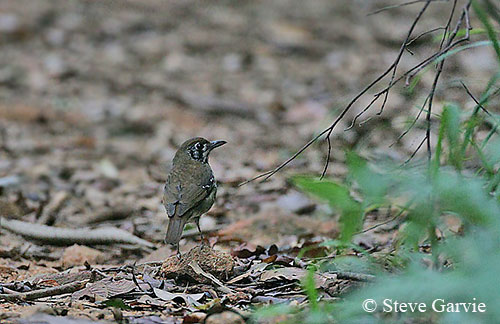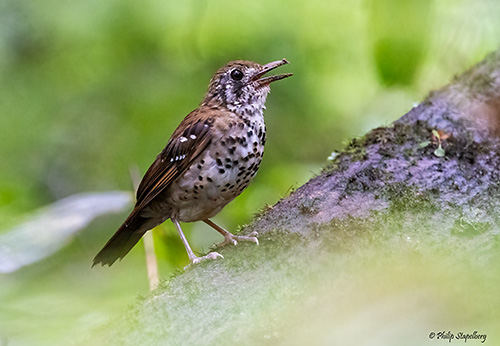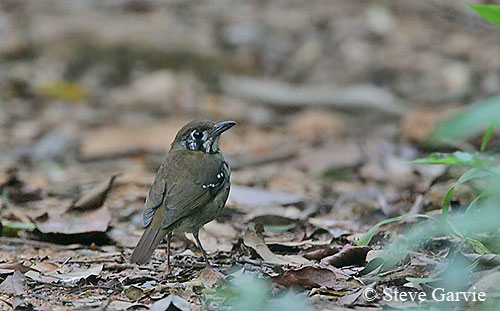
Fr: Grive à ailes tachetées
Ang: Spot-winged Thrush
All: Fleckflügeldrossel
Esp: Zorzal Alimoteado
Ita: Tordo alimacchiate
Nd: Vlekvleugellijster
Sd: fläckvingad trast
Photographers:
Jean Michel Fenerole
Photos d’Oiseaux du monde
Steve Garvie
RAINBIRDER Photo galleries
Philip Stapelberg
GALLERY
Alan & Ann Tate
AA Bird Photography
Text by Nicole Bouglouan
Sources:
HANDBOOK OF THE BIRDS OF THE WORLD Vol 10 by Josep del Hoyo-Andrew Elliott-David Christie - Lynx Edicions - ISBN: 8487334725
THRUSHES by Peter Clement and Ren Hathway – HELM - ISBN: 0713639407
Sri Lanka – Wild Parks and Wild Life
Wikipedia, the free encyclopaedia
Spot-winged Thrush
Geokichla spiloptera
Passeriformes Order – Turdidae Family
INTRODUCTION:
The Spot-winged Thrush is endemic to Central and South Sri Lanka, and resident breeder.
It is mainly found in the foothills of the wet zone, although the species can be scarce and local in riverine forests in the dry zone. It is usually visible between 500 and 2,000 metres of elevation, depending on the season.
It is omnivorous and feeds on small invertebrates including mainly insects, and also takes fruit and berries. It is solitary and usually inconspicuous, sometimes venturing into the open at dusk. It forages mainly on the ground among leaf-litter, shrubs and bushes.
As most Turdidae do, this species builds a large, cup-shaped nest in small tree, top of bush or occasionally on the ground among tree roots. Both adults share the nesting duties.
The Spot-winged Thrush is affected by destruction and fragmentation of the habitat, involving reduction of food resources and nesting sites. The species is currently listed as Near Threatened.
DESCRIPTION OF THE BIRD:
Biometrics:
Length: 21-23 cm
Weight: 70 g
The Spot-winged Thrush has olive-brown upperparts becoming browner across the lower back, rump and uppertail-coverts. The tail is brown or washed olive at base and edges of outermost rectrices.
On the upperwing, lesser coverts and scapulars are olive-brown, with pale tips to outer feathers. The median coverts are blackish-brown with white tips too. The greater coverts are similar, with also olive-brown edges. The white tips of both median and greater coverts form two conspicuous white wingbars. The alula is brown, slightly paler than the primary coverts.
The flight-feathers are brown. The primaries show broad, paler brown edges. The secondaries have darker edges. The tertials are almost uniformly brown.

The underparts, including chin and throat, are whitish. Sides of lower throat, breast, belly and flanks are heavily spotted with inverted fan-shaped black spots, smaller on belly and flanks. A grey to olive-brown wash is visible on sides of breast and flanks. Vent and undertail-coverts are uniformly white.
On the head, forehead to crown is olive-brown. The lores are whitish. We can see a broad, whitish submoustachial stripe and a finely barred blackish and broken malar stripe.
A broad, dark brown, vertical stripe extends from below the eye to the side of the throat. The ear-coverts are whitish with blackish rear edge and white tips to rear of border on neck sides.
The bill is blackish, slightly paler at base of lower mandible.
The eyes are dark brown with white eyering, and conspicuous white crescent on the rear half of the eye.
Legs and feet are bluish-grey to greyish-flesh.
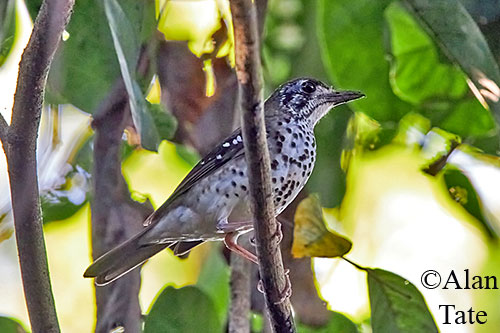
Male and female are similar.
The juvenile resembles adult but the plumage is tinged rustier. The scapulars show buff shaft streaks.
The underparts are dull buff with less pronounced spotting.
The characteristic facial pattern is more indistinct in the young birds.
RANGE:
The Spot-winged Thrush is found in Central and South Sri Lanka.
HABITAT:
The Spot-winged Thrush frequents the damp, evergreen forest of the wet zone of C and S Sri Lanka. Within this habitat, it frequents the undergrowth and bamboo clumps in the dense rainforests, up to 2,200 metres, but it is commoner between 450 and 1,500 metres.
It is also found in secondary scrub, plantations and gardens along the forest edges.
Some scattered populations are observed in drier woodlands.
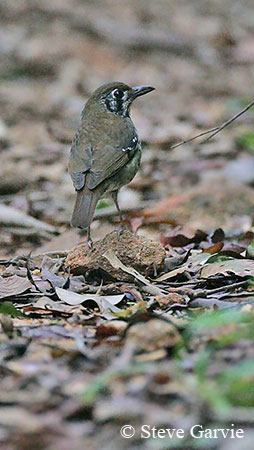
CALLS AND SONGS: SOUNDS BY XENO-CANTO
The Spot-winged Thrush is a beautiful songster which produces rich whistling notes. The song is a varied and sweet series of short whistled phrases, sometimes resembling those given by humans. It is described as “piii, piii-puu,piii,pip-piii, piii, piii-puu”.
The bird usually sings from a low perch in tree or in dense thicket. The song is mainly given in the early morning and just before dusk.
This species is very territorial and maintains the territory all year round by singing. The male gives a “defensive song” to defend the territory.
The contact call is a very soft, grasshopper-like “tzseee”, and we can also hear a quiet “chik-chik” for contact.
The alarm call is a weak single chirping note “kriiis”. It also utters a high-pitched call as a warning to its mate.
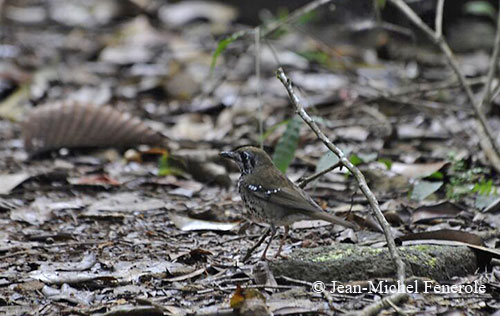
The Spot-winged Thrush lives in pairs or solitary. It is usually shy and inconspicuous, often well hidden in dense vegetation. It may sometimes venture into the open at dusk, usually along tracks within the forest.
It is territorial throughout the year and the male defends the area by singing.
The nuptial behaviour of this species is unknown, but they are monogamous with the pair bonds lasting all the year. The courtship displays of Turdidae species generally include chases between male and female, and then, both mates fly together. Courtship feeding by male to female is also reported.
The nest is a large cup-shaped structure placed in low fork in small tree. It resembles a mass of vegetal debris. This species produces two or three broods per year.
The Spot-winged Thrush is endemic and resident breeder in Sri Lanka. It spends the winter in similar habitats including less wooded areas between 750 and 1,500 metres of elevation.
The flight is usually fast, but it becomes more undulating across open areas. However, this species is primarily terrestrial.
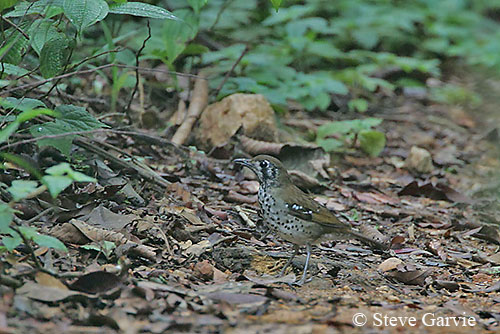
REPRODUCTION OF THIS SPECIES:
The breeding season takes place mainly in March-May, and again in August-November.
The nest of the Spot-winged Thrush is usually a very ragged cup resembling a mass of vegetal debris. It is made of green moss, dead leaves and small twigs. The cup is lined with small fern fronds, moss, rootlets and fine hair or plant fibres. It is recognisable by large scraps of materials hanging below the cup.
The nest is placed low in small tree or in crown of tree fern, or also among tree roots on a bank. It is generally built between 1,5 and 3 metres above the ground.
The female lays 2-3 pale buff or bluish-green eggs with darker markings. The duration of the incubation is unknown, but both parents probably incubate and feed the chicks.
This species produces two or three broods per year.
PROTECTION / THREATS / STATUS:
The Spot-winged Thrush is affected by habitat loss, caused by degradation and fragmentation of forest for agriculture expansion, gathering of fuelwood, fire, urbanisation and logging.
Snakes and Sri Lanka Blue Magpie are known predators of the nests.
The size of the population is unknown, and the species is described as uncommon to locally common. The population is suspected to be declining due to habitat loss.
The Spot-winged Thrush is currently listed as Near Threatened.
